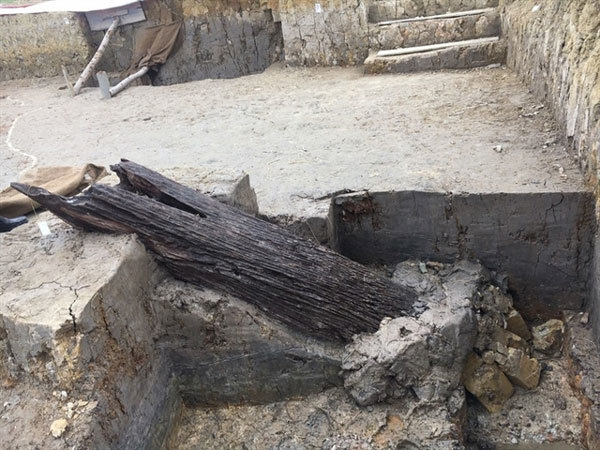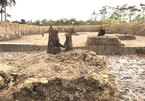 |
| Hai Phong authorities have filled up excavation holes in Cao Quy field and marked the stakes for later research. Photo giadinh.net.vn |
Do Xuan Trung, director of Hai Phong Museum, said at present local scientists have no proper way to preserve the 36 stakes found in the field.
“We decided not to excavate any more in the field, but examine surrounding areas,” he said.
Le Van Thanh, secretary of Hai Phong City's Party Committee, asked the scientists to examine the area thoroughly.
He also asked concerned agencies to adjust building plans around the area and proceed to recognise Cao Quy stakes as a historical relic site, preparing to ask for the State’s recognition as a relic site.
Between November 27 and December 19, the Vietnam Archaeology Institute in co-ordination with Hai Phong Department of Culture and Sports and Hai Phong Museum excavated three holes over a total area of 950sq.m.
They found 27 firm dark-red wooden stakes buried in silt. All the stakes’ heads were broken. On the stakes, there are traces of nails for tying up string.
According to radio carbon dating, the stakes were made between 1270 and 1430 AD.
 |
| Wooden stakes can be better preserved in soil as at present scientists have no proper preservation method if they take the stakes from the soil. Photo moitruongvadothi.vn |
Scientists initially concluded that the field was on a stream leading to Bach Dang River, with big and small wooden stakes installed alternatively creating different layers.
The site might have been part of a trap made by the Đại Việt [then Vietnam] army to repel Yuan-Mongol invaders’ boats in 1288.
The stakes would have been deployed by Tran Dynasty (1226-1400) fighters as a trap to destroy enemy boats and divert them to follow their planned waterway to Bach Dang River, where another stake trap was installed to completely defeat the enemy boats.
Dai Viet army won the battle that time, which was a historic victory to weaken the Yuan-Mongol empire and prevented them from invading Japan and Southeast Asia, according to historians.
The empire invaded Dai Viet three times (1257-58; 1284-85 and 1287-88), and lost it all.
Traces of the same wooden stakes have been found in Yen Giang, Dong Van Muoi and Dong Ma Ngua in northern province of Quang Ninh. VNS

Evidence of Battle of Bach Dang uncovered in Haiphong
Archaeologists have detected many wooden stakes in the northern city port of Haiphong which are thought to be related to the historic battle of Bach Dang in 1288.

Ancient war trap shows great campaign by Tran army in 13th century
Archaeologists have recently unearthed wooden stakes that are thought to have been planted in a river in the coastal city of Hai Phong to repel Yuan-Mongol invaders' boats and secure the Bach Dang River victory in 1288 for Dai Viet (then Vietnam).
 Agencies in the northern coastal city of Hai Phong have filled in three excavation holes in Cao Quy field, Lien Khe Commune, Thuy Nguyen District, where dozens of 13th century stakes were unearthed in November 2019." itemprop="description" />
Agencies in the northern coastal city of Hai Phong have filled in three excavation holes in Cao Quy field, Lien Khe Commune, Thuy Nguyen District, where dozens of 13th century stakes were unearthed in November 2019." itemprop="description" />